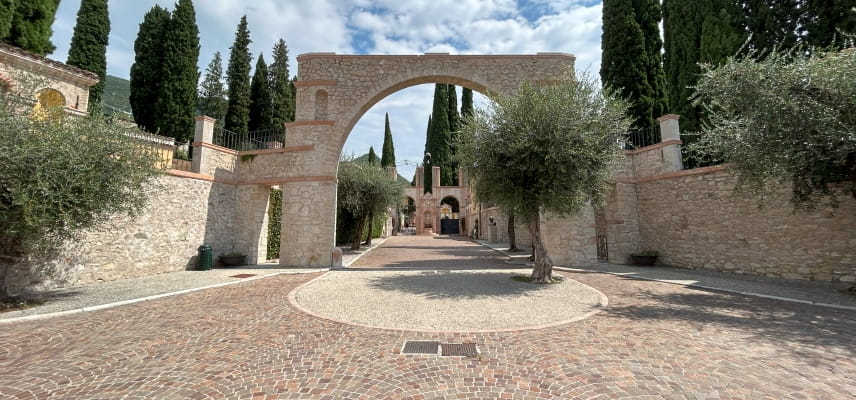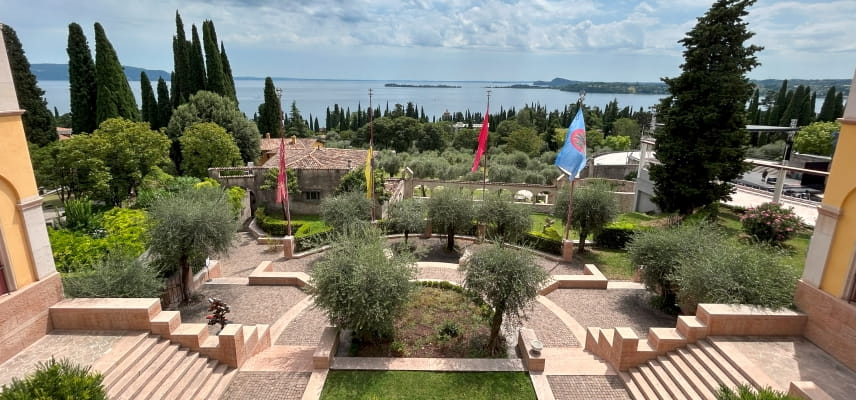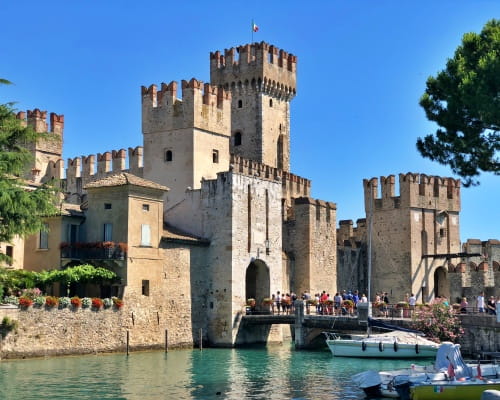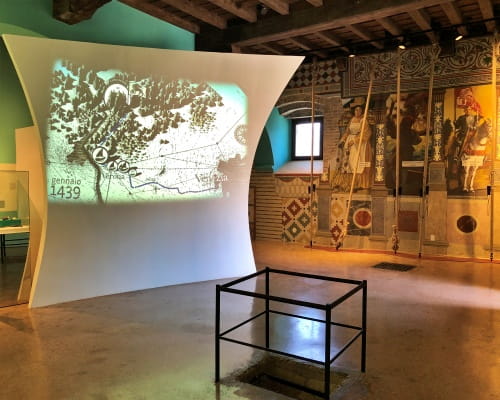Il Vittoriale degli Italiani
A practical guide to Gabriele D'Annunzio's house-museum, a real treasure in Gardone Riviera on Lake Garda.
In Gardone Riviera, on the western shore of Lake Garda, stands Il Vittoriale degli Italiani, the house-museum of Gabriele D'Annunzio.
Il Vittoriale degli Italiani is the result of a long and complex process of transformation and extension of Villa Cargnacco, an Art Nouveau mansion purchased by Gabriele D'Annunzio in 1921. The Poet, fascinated by its panoramic position and view of the lake, decided to make it his home and turn it into a monument to his life and achievements.
On 22 December 1923, Gabriele D'Annunzio donated the entire Vittoriale property to the Italian people, which subsequently became a national monument on 28 May 1925. Just a year before the Poet's death, on 17 July 1937, the Vittoriale became a Foundation, managed by a President and a Board of Directors, directly appointed by the Head of State.
To realise his project, D'Annunzio enlisted the help of architect Giancarlo Maroni, who was responsible for coordinating the work and harmonising the different parts of the building complex. Work began in 1921 and lasted until D'Annunzio's death in 1938, with various phases and works.
The first phase involved the renovation of Villa Cargnacco, which was enlarged by adding new rooms and decorated with works of art, furniture, books and memorabilia from D'Annunzio's previous homes. The villa, renamed the Priory, became the heart of the Vittoriale and the place where the Poet lived and wrote his last works.
The second phase involved the construction of the Mausoleum, the burial place of D'Annunzio and his loyalists. Situated on top of a small hill, the Mausoleum looks like a pyramidal structure inspired by Egyptian and Roman monuments, with a monumental staircase and an underground crypt. Completed in 1933, it houses the tombs of D'Annunzio and nine of his comrades-in-arms.
The third phase involved the construction of the Amphitheatre, an open-air theatre in Greco-Roman style that can seat up to 1,500 spectators. Dedicated to the memory of the fallen of World War I, since 2011 it hosts the Tener-a-mente Festival. The theatre is adorned with statues, columns and bas-reliefs recalling mythology and ancient history.
The fourth phase involved the enrichment of the park and gardens, which cover about 9 hectares and house various works and installations. These include the military vessel Puglia, a warship used by D'Annunzio during the Fiume enterprise, the MAS 96, an armed torpedo motorboat used during the famous "Beffa di Buccari" (Buccari Hoax), and the SVA aeroplane, a biplane used for the flight over Vienna.
The Rooms of the Priory: the home of Gabriele D'Annunzio
Priory is the name that Gabriele D'Annunzio gave to his house-museum inside the Vittoriale degli Italiani. The term prioria means 'prior's house', and recalls the idea of a monastic dwelling, where the poet used to retreat to meditate and write.
The Priory is composed of numerous rooms and each has a specific name and function. The life and personality of D'Annunzio, his eclectic and refined taste, his love of art and literature, his patriotic and indomitable spirit can still be perceived in these rooms.
These are, in brief, some of the most important rooms in the Priory:
- Vestibolo, the real entrance to the house, a place of strong mystical and religious significance. At the top of seven steps symbolising the vices and virtues, a small column from Assisi stands in a central position, a reminder of the poverty of the Franciscan order. Halfway up the steps are two golden lions and at the bottom two doors lead to the Oratorio Dalmata and the Stanza del Mascheraio respectively.
- Oratorio Dalmata, the place used as a waiting room for welcome guests, houses some 16th-century seats. Above them are indicated the seats reserved for the prior, vice prior and chancellor. It owes its name to the presence of a statue of a lion from the Dalmatian town of Arbe (Croatia).
- Stanza del Mascheraio, the place used as a waiting room for unwelcome guests and official visits, where Mussolini apparently waited for over two hours. The room contains around nine hundred books, a radio, some musical sheets and a gramophone.
- Stanza della Leda, D'Annunzio's bedroom, where there is his four-poster bed, decorated with a sculpture of Leda and the swan, and his wardrobe where he kept his clothes and personal belongings.
- Stanza della Musica, where D'Annunzio listened to his favourite records, played the piano and violin, and received musicians. The room is furnished with musical instruments, paintings and busts of famous composers.
- Stanza del Lebbroso, the place where D'Annunzio withdrew to work, isolating himself from the outside world. The room is so called because it contains a mask of a leper, symbolising the Poet's condition of marginalisation and suffering. The room is filled with books, manuscripts, typewriters and various objects.
- Stanza del Mappamondo, where D'Annunzio followed the political and military events of his time. The room contains a large globe, a desk, a radio, an Italian flag and a number of medals and decorations.
- Stanza delle Reliquie, where D'Annunzio kept his most precious memorabilia, related to his wartime and literary exploits. The room contains, among other things, the red cloak he wore during the Fiume feat, the sword he received from Vittorio Emanuele III, the original manuscript of La Nave, and the gold book of the fallen of the First World War.
- Zambracca, the antechamber to the Stanza della Leda, houses D'Annunzio's clothing and personal belongings. In this room the Poet attended to his last chores and here, at his desk, he died on 1 March 1938.
- Veranda dell'Apollino, used by the Poet as a reading room. The room contains copies of Italian Renaissance paintings, porcelain animal figures, carpets and ceramics.
- Bagno Blu, divided into two zones in the French style, it houses more than 600 Oriental-style objects, the dominant colours of which are blue and green.
- Corridoio della Via Crucis, so called due to the presence of some enamelled copper forms depicting the fourteen stages of the Passion of Christ. From the windows it is possible to admire the Cortiletto degli Schiavoni and the Portico del Parente.
- Stanza del Giglio, a room containing around three thousand books of Italian literature and history. Decorated with several panels depicting lilies, it also contains a small harmonium and a collection of apothecary jars.
- Corridoio del Labirinto, is inspired by the famous ceiling of the Ducal Palace in Mantua and is used here to decorate the doors and bindings of two thousand books of French literature.
- Officina, or D'Annunzio's studio, the only room in the Priory directly lit by sunlight. This room was the place where D'Annunzio wrote for many hours a day and where he wrote the "Secret Book", his final work.
- Clausura, the most secret area of the Priory and the only one open to the public just for some events. The Poet's women lived in these rooms: Aélis Mazoyer, Luisa Baccara, the housekeeper and other mistresses, who prepared themselves here to entertain him.
- Scrittoio del Monco, the room used by the Poet for sorting his correspondence. D'Annunzio, in order to avoid or being unable to reply to everyone, jokingly said he was mutilated and therefore unable to write.
- Stanza della Cheli, or D'Annunzio's dining room. Completed in 1929, it takes its name from a bronze tortoise (khélis means tortoise in Greek) by Renato Brozzi, made from the shell of a real tortoise given to Gabriele D'Annunzio by Marchesa Luisa Casati and who died in the Vittoriale park after eating too much. Its presence in the room is a warning against gluttony.
- Schifamondo, a new section of the mansion designed in 1926 by architect Giancarlo Maroni. This section is so called due to the contempt for the world that tormented D'Annunzio from the mid-1920s onwards. The interior spaces are very different from the previous ones and in line with the trends of the 1930s.
- Stanza dei Calchi, now part of the "D'Annunzio the Hero" Museum, houses wartime memorabilia that belonged to the poet. The collection includes the Isotta Fraschini engine of the SVA aeroplane used for the famous flight over Vienna, the Gonfalone of the Italian Regency of Carnaro and the waxed canvas cloak worn during the "Beffa di Buccari". There is also a display case containing the manuscript of the Notte di Caprera, composed by Gabriele D'Annunzio and dedicated to Giuseppe Garibaldi.
- Auditorium, a large hall with a polygonal structure, used to host various events and conferences. Particularly important and scenic is the presence on the ceiling of the hall of the legendary two-seater SVA aeroplane with which D'Annunzio flew over Vienna on 9 August 1918.
The Vittoriale Park: an ode to beauty in all its forms
The entrance to the Vittoriale consists of a two-arched portal with a small fountain in the centre and a D'Annunzio inscription. The upper part features a knave's helmet surrounded by two cornucopias, the coat of arms of the Prince of Montenevoso and D'Annunzio's motto "Io ho quel che ho donato" (I have what I have given).
The visit to Il Vittoriale degli Italiani begins at the ticket office and continues to the Secret D'Annunzio Museum. This is a space under the stage of the amphitheatre, where you can see some personal items of the Poet and his mistresses, such as clothes, jewellery, suitcases and shoes. The museum also hosts some temporary exhibitions. At the entrance to this area, there are two bronze sculptures by Ugo Riva.
The Vittoriale Park tour then leads to the Nicchia dell'Enigma (Niche of the Enigma), continuing to the Arco dell'Ospite (Arch of the Guest) and the piazzetta del Pilo del Piave (Pilo del Piave Square). The latter structure, consisting of a tall pylon, stands in memory of Caporetto. Above the pylon, there is a statue of the Winged Victory of the Piave, a work by Arrigo Minerbi and donated to the Poet in May 1935, by the city of Milan.
Nearby is the Pilo del "Dare in Brocca" (hitting the bull's-eye), wanted by the Poet to commemorate the feat of Fiume. This monument features a marble decoration by Guido Marussig, consisting of three arrows hitting the centre of the target.
Curious fact - In 1925, the young Pier Giuseppe Beretta, owner of the Beretta firearms company, noticed the frieze with the three arrows while visiting the Vittoriale and decided to use it as his company's trademark.
To the left of the park's entrance avenue is the Giardino delle Vittorie (Garden of Victories) and a little further on is the splendid Amphitheatre. Work to build it began in 1931. The work was only partially completed in 1952 and unfortunately the Poet and architect Maroni never got to see it finished.
It was only in 2020 that the Amphitheatre project was completely finished. Thanks to the contribution of the Lombardy Region, the covering of the tiers with red Verona marble was added, exactly as the Poet had imagined.
The structure is in complete harmony with the surrounding landscape and offers a unique viewpoint towards the southern basin of Lake Garda. During the summer season, numerous national and international artists perform here during the Tener-a-mente Festival.
A short walkway leads to Piazza dell'Esedra (Esedra Square), designed in a semicircular shape and adorned with double arches surmounted by several flagpoles. Next to the Esedra is the Tempietto delle memorie dannunziane (Small Temple of Memories), where the poet was initially buried until 1963.
This place leads to the Piazzetta Dalmata (Dalmata Square), the actual centre of the Vittoriale. This place takes its name from the stone Pilo above which stands the statue of the Virgin with the sceptre of Dalmatia.
Facing the Piazzetta Dalmata is the Priory and from this point it is possible to reach all the other areas of the Park, such as the Dog Pound or the Dolphin Fountain and walk along the Viale di Aligi to the shelter of MAS 96, the bow of the Royal Ship Puglia and the Mausoleum.
The dog pound, strongly desired by the Poet, was recently renovated and opened to the public. Gabriele d'Annunzio loved noble dog breeds, especially greyhounds.
In the surrounding area of the Priory, the itinerary passes through the characteristic Portico del Parente (Portico of the Relative), named in honour of Michelangelo, an artist to whom D'Annunzio felt particularly attached, and then the Cortiletto degli Schiavoni (Courtyard of Schiavoni), with the characteristic well and the Prince of Montenevoso emblem in the centre, positioned outside the Leper Room.
The Dolphin Fountain features a bronze statue of Aphrodite, emerging from the water together with a dolphin. The waterfall visible in the fountain, originally came from the Rivotorto stream. Later, architect Maroni, at the behest of D'Annunzio, separated the stream into two courses, later called Acqua Pazza and Acqua Savia.
Nearby is the shelter of MAS 96, the boat used by Gabriele D'Annunzio during the famous "Beffa di Buccari" (Buccari Hoax). Donated to the Poet in 1923 by Admiral Thaon di Revel, it was initially moored at the nearby Torre San Marco and used for some outings on Lake Garda. On the entrance wall of the shelter is the inscription "Memento Audere Semper" (remember to always dare), in homage to the name MAS.
The visit inside the Vittoriale park continues to a particular construction: the Mausoleum.
Situated on a hill dominating the entire surrounding area, the Mausoleum is the resting place of Gabriele D'Annunzio, together with the remains of the Fiume legionnaires closest to him and his friend, architect Giancarlo Maroni. The current building was constructed after the Poet's death, similar to the burial mounds of the ancient Romans.
Another monument, among the most significant and photographed by tourists visiting the Vittoriale, is certainly the Royal Ship Puglia.
Given to the Poet for his 60th birthday by Admiral Thaon di Revel, the Royal Ship Puglia is a unique monument of its kind. The ship was completely disassembled and loaded onto several railway wagons, then transported to Gardone and reassembled in its current position, with the bow facing the Adriatic Sea.
The bow of the Royal Ship Puglia is decorated with a splendid figurehead, a winged Victory by sculptor Renato Brozzi. In the ship's hold there is the Onboard Museum, in which various models of warships are exhibited.
Below the ship, the path descends the hill until it reaches the beautiful Laghetto delle Danze (Pond of the Dances), a violin-shaped stone reservoir formed by the union of the Acqua Pazza stream and the Acqua Savia stream.
To complete the visit to the Vittoriale, a new exhibition space called Museo "L'Automobile è femmina" was opened in 2017. Accessible directly from the main road, it occupies the spaces that once housed the Poet's cars.
These cars are true masterpieces of engineering and mechanics, such as the Fiat Tipo 4 used for the entrance to the city of Fiume, the Isotta Fraschini Tipo 8B, the splendid Alfa Romeo 6C 2300 T, nicknamed "Satan's Breath", and numerous automotive memorabilia.
Il Vittoriale degli Italiani is therefore an architectural and artistic work of great value and originality, bearing witness to the creativity and genius of Gabriele D'Annunzio and offering visitors a glimpse into the culture and history of 20th century Italy.
The Vittoriale museum is easily accessible by car, train or bus, thanks to its strategic location between the cities of Brescia, Verona and Trento. The museum has a large pay car park for visitors, located in the immediate surroundings of the entrance.
Inside the park there is also a small café, where it is possible to enjoy a coffee, an ice cream or a sandwich while admiring the greenery and the beauty of the landscape.
Please note that it is possible to visit the Park only, or choose for a more in-depth visit that includes the Park and the Priory. The visit to the Priory is guided, lasts about 35 minutes and is organised in small groups of 10 people.
Il Vittoriale degli Italiani is a must-see for lovers of literature, history and art, but also for those who want to enjoy a breathtaking view of Lake Garda, in an elegant and evocative atmosphere.
Image gallery
Click on the button below to open the image gallery.
How to get to Il Vittoriale degli Italiani
Click on the button below to open the detailed map.
What to see on Lake Garda
Many other sights await you, discover them below!






